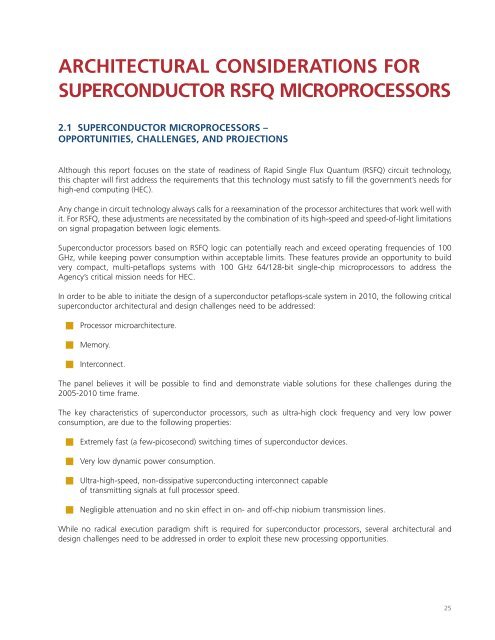Superconducting Technology Assessment - nitrd
Superconducting Technology Assessment - nitrd
Superconducting Technology Assessment - nitrd
You also want an ePaper? Increase the reach of your titles
YUMPU automatically turns print PDFs into web optimized ePapers that Google loves.
ARCHITECTURAL CONSIDERATIONS FOR<br />
SUPERCONDUCTOR RSFQ MICROPROCESSORS<br />
2.1 SUPERCONDUCTOR MICROPROCESSORS –<br />
OPPORTUNITIES, CHALLENGES, AND PROJECTIONS<br />
Although this report focuses on the state of readiness of Rapid Single Flux Quantum (RSFQ) circuit technology,<br />
this chapter will first address the requirements that this technology must satisfy to fill the government’s needs for<br />
high-end computing (HEC).<br />
Any change in circuit technology always calls for a reexamination of the processor architectures that work well with<br />
it. For RSFQ, these adjustments are necessitated by the combination of its high-speed and speed-of-light limitations<br />
on signal propagation between logic elements.<br />
Superconductor processors based on RSFQ logic can potentially reach and exceed operating frequencies of 100<br />
GHz, while keeping power consumption within acceptable limits. These features provide an opportunity to build<br />
very compact, multi-petaflops systems with 100 GHz 64/128-bit single-chip microprocessors to address the<br />
Agency’s critical mission needs for HEC.<br />
In order to be able to initiate the design of a superconductor petaflops-scale system in 2010, the following critical<br />
superconductor architectural and design challenges need to be addressed:<br />
■ Processor microarchitecture.<br />
■ Memory.<br />
■ Interconnect.<br />
The panel believes it will be possible to find and demonstrate viable solutions for these challenges during the<br />
2005-2010 time frame.<br />
The key characteristics of superconductor processors, such as ultra-high clock frequency and very low power<br />
consumption, are due to the following properties:<br />
■ Extremely fast (a few-picosecond) switching times of superconductor devices.<br />
■ Very low dynamic power consumption.<br />
■ Ultra-high-speed, non-dissipative superconducting interconnect capable<br />
of transmitting signals at full processor speed.<br />
■ Negligible attenuation and no skin effect in on- and off-chip niobium transmission lines.<br />
While no radical execution paradigm shift is required for superconductor processors, several architectural and<br />
design challenges need to be addressed in order to exploit these new processing opportunities.<br />
25










